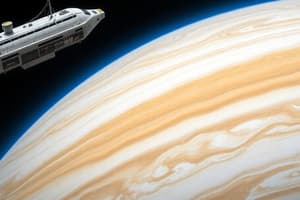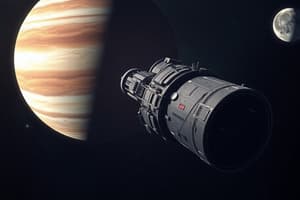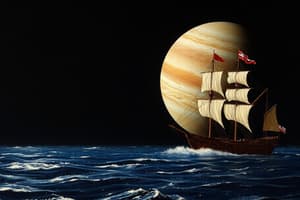Podcast
Questions and Answers
Considering the constraints of the Europa Clipper mission, what is the most significant limitation in directly confirming the existence of life on Europa?
Considering the constraints of the Europa Clipper mission, what is the most significant limitation in directly confirming the existence of life on Europa?
- The spacecraft lacks the necessary instruments to detect microbial life, focusing instead on habitability factors.
- The mission's primary objective is to analyze the chemical composition of Europa's surface ice, not its subsurface ocean.
- Due to energy limitations, the spacecraft cannot perform high-resolution scans needed to identify potential biosignatures.
- The Europa Clipper will not land on Europa, preventing direct sample collection and analysis for living organisms. (correct)
The Europa Clipper uses gravity assist maneuvers to reach Jupiter. What is the primary reason for employing this technique, considering the mission's objectives and constraints?
The Europa Clipper uses gravity assist maneuvers to reach Jupiter. What is the primary reason for employing this technique, considering the mission's objectives and constraints?
- To minimize the stress on the spacecraft's structure during its long journey.
- To reduce the amount of fuel required for the mission, enabling a longer operational period around Europa. (correct)
- To calibrate the spacecraft's instruments using the gravitational fields of other planets.
- To precisely align the spacecraft's trajectory for optimal data collection during Europa flybys.
Europa's potential habitability is strongly linked to the presence of liquid water maintained by tidal heating. What is the most critical implication of this heating mechanism for the potential development of life?
Europa's potential habitability is strongly linked to the presence of liquid water maintained by tidal heating. What is the most critical implication of this heating mechanism for the potential development of life?
- It provides a consistent energy source that could support chemosynthesis, independent of sunlight. (correct)
- It creates diverse thermal niches within the ocean, fostering a variety of microbial ecosystems.
- It ensures a stable temperature gradient throughout Europa's icy shell, facilitating nutrient transport.
- It prevents the accumulation of toxic substances in the ocean, maintaining a habitable chemical environment.
Considering the radiation environment around Jupiter, how does the Europa Clipper's mission design mitigate the risks to its scientific instruments and overall functionality?
Considering the radiation environment around Jupiter, how does the Europa Clipper's mission design mitigate the risks to its scientific instruments and overall functionality?
The Europa Clipper mission is designed to conduct multiple flybys of Europa rather than maintain a stable orbit around the moon. What is the most likely reason for this approach, given the mission's objectives?
The Europa Clipper mission is designed to conduct multiple flybys of Europa rather than maintain a stable orbit around the moon. What is the most likely reason for this approach, given the mission's objectives?
NASA plans to crash the Europa Clipper into Ganymede at the end of its mission. What is the most plausible explanation for this controlled deorbiting, considering planetary protection protocols?
NASA plans to crash the Europa Clipper into Ganymede at the end of its mission. What is the most plausible explanation for this controlled deorbiting, considering planetary protection protocols?
Europa's surface is believed to contain elements necessary for life, such as carbon, nitrogen, and oxygen. However, what critical process is required to make these elements accessible and usable for potential microbial life in the subsurface ocean?
Europa's surface is believed to contain elements necessary for life, such as carbon, nitrogen, and oxygen. However, what critical process is required to make these elements accessible and usable for potential microbial life in the subsurface ocean?
The Europa Clipper mission aims to estimate the thickness of Europa's icy shell. What is the most significant implication of determining this thickness for assessing the moon's habitability?
The Europa Clipper mission aims to estimate the thickness of Europa's icy shell. What is the most significant implication of determining this thickness for assessing the moon's habitability?
The article mentions that Europa Clipper will examine the ocean below the moon's icy surface. Which remote sensing technique is least likely to provide insights into the composition and properties of this subsurface ocean?
The article mentions that Europa Clipper will examine the ocean below the moon's icy surface. Which remote sensing technique is least likely to provide insights into the composition and properties of this subsurface ocean?
While Europa Clipper's explicitly stated mission is not to directly search for life, the data it collects will be crucial for future astrobiological missions. What aspect of Europa's environment would be most informative for designing a subsequent mission aimed at detecting life?
While Europa Clipper's explicitly stated mission is not to directly search for life, the data it collects will be crucial for future astrobiological missions. What aspect of Europa's environment would be most informative for designing a subsequent mission aimed at detecting life?
Flashcards
Europa
Europa
Jupiter's fourth largest moon, a prime candidate for potential alien life.
Europa Clipper
Europa Clipper
The spacecraft launched by NASA to explore Europa and determine if it has areas that could support life.
Key ingredients for alien life
Key ingredients for alien life
Liquid water, energy, and the right chemical elements.
Europa's energy source
Europa's energy source
Signup and view all the flashcards
Gravity Assist
Gravity Assist
Signup and view all the flashcards
Europa Clipper Mission Goal
Europa Clipper Mission Goal
Signup and view all the flashcards
Ganymede
Ganymede
Signup and view all the flashcards
Study Notes
- NASA launched the Europa Clipper spacecraft to Jupiter's moon, Europa, on October 14, 2024, from the Kennedy Space Center in Florida.
- The spacecraft is the largest ever built for a planetary mission.
- It successfully entered orbit about an hour and 10 minutes after launch and deployed its solar arrays.
- NASA Administrator Bill Nelson stated that this mission marks the first journey to an ocean world beyond Earth.
Why Europa?
- Europa is a primary candidate for alien life due to the potential presence of liquid water, energy, and essential chemical elements.
- Scientists believe a large saltwater ocean lies beneath Europa's icy crust, possibly containing twice the amount of water as Earth's oceans.
- Jupiter's gravitational pull on Europa likely serves as an energy source, generating heat that prevents the underground ocean from freezing.
- Europa's surface may contain elements like carbon, nitrogen, and oxygen.
- These conditions together could potentially support microbial life.
Getting to Europa
- Jupiter is approximately 480 million miles (772 million km) from Earth.
- Europa Clipper will travel 1.8 billion miles (2.8 billion km) over 5.5 years to reach Europa.
- The spacecraft will use "gravity assist" maneuvers to gain speed.
- It will fly past Mars in February 2025 and swing by Earth in December 2025 for a final boost.
The Mission
- Europa Clipper is scheduled to enter Jupiter's orbit in April 2030.
- It will spend about a year preparing for its first flyby of Europa.
- The spacecraft will fly by Europa 49 times over three years, mapping different areas of the moon.
- It will get as close as 16 miles (25 km) to Europa's surface.
- The data collected by Europa Clipper's nine instruments will help determine the thickness of Europa's icy shell and understand the ocean beneath.
- Scientists hope to learn more about the composition of the water.
- The mission aims to determine if areas below Europa's surface could support life, not to directly search for life.
- Upon completing its mission, the spacecraft will deliberately crash into Ganymede, Jupiter's largest moon and the largest in the solar system.
- Bill Nelson stated that Europa Clipper will help understand the potential for life beyond our solar system.
Studying That Suits You
Use AI to generate personalized quizzes and flashcards to suit your learning preferences.





